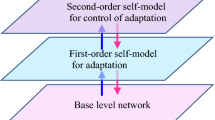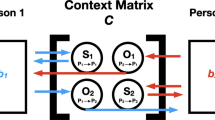Abstract
Since Condon’s annotations of videotaped interactions in 1966, an increasing amount of studies points the crucial role of non-verbal behaviours in communication. Among others, synchrony between interactants is claimed to be an evidence of the interaction quality: to give to humans a feeling of natural dialogue, agents must be able to react on appropriate time. Recent dynamical models propose that synchrony emerges from the coupling between interactants. We propose here, and test in simulation, a model of verbal communication which links the mutual understanding of dialogue partners to the emergence of synchrony between their non-verbal behaviours: if interactants understand each other, synchrony emerges; if they do not understand, synchrony is disrupted. In addition to propose and test a model explaining the link between synchrony and interaction quality (synchrony accounts for mutual understanding and good interaction, di-synchrony accounts for misunderstanding) our tests point the fact that synchronisation and di-synchronisation emerging from mutual understanding are fast phenomenons: agents have a quick answer to whether they understand each other or not.
Access this chapter
Tax calculation will be finalised at checkout
Purchases are for personal use only
Preview
Unable to display preview. Download preview PDF.
Similar content being viewed by others
References
Auvray, M., Lenay, C., Stewart, J.: Perceptual interactions in a minimalist virtual environment. New Ideas in Psychology 27, 32–47 (2009)
Chammat, M., Foucher, A., Nadel, J., Dubal, S.: Reading sadness beyond human faces. Brain Research (2010) (in Press, accepted, manuscript)
Condon, W.S.: An analysis of behavioral organisation. Sign Language Studies 13, 285–318 (1976)
Condon, W.S., Ogston, W.D.: Sound film analysis of normal and pathological behavior patterns. Journal of Nervous and Mental Disease 143, 338–347 (1966)
Dubal, S., Jouvent, A.F.R., Nadel, J.: Human brain spots emotion in non humanoid robots. Social Cognitive and Affective Neuroscience (2010) (in press)
Ducan, S.: Some signals and rules for taking speaking turns in conversations. Journal of Personality and Social Psychology 23(2), 283–292 (1972)
Dumas, G., Nadel, J., Soussignan, R., Martinerie, J., Garnero, L.: Inter-brain synchonization during social interaction. PLoS One 5(8), e12166 (2010)
Bernieri, F.J.: Coordinated movement and rapport in teacher-student interactions. Journal of Nonverbal Behavior 12(2), 120–138 (1988)
Gaussier, P., Cocquerez, J.: Neural networks for complex scene recognition :simulation of a visual system with several cortical areas. In: IJCNN, Baltimore, pp. 233–259 (1992)
Gaussier, P., Zrehen, S.: Avoiding the world model trap: An acting robot does not need to be so smart. Journal of Robotics and Computer-Integrated Manufacturing 11(4), 279–286 (1994)
Hatfield, E., Cacioppo, J.L., Rapson, R.L.: Emotional contagion. Current Directions in Psychological Sciences 2, 96–99 (1993)
Kendon, A.: Conducting Interaction: Patterns of Behavior in Focused Encounters. Cambridge University Press, Cambridge (1990)
LaFrance, M.: Nonverbal synchrony and rapport: Analysis by the cross-lag panel technique. Social Psychology Quarterly 42(1), 66–70 (1979)
Matsumoto, D., Willingham, B.: Spontaneous facial expressions of emotion in congenitally and non-congenitally blind individuals. Journal of Personality and Social Psychology 96(1), 1–10 (2009)
Mertan, B., Nadel, J., Leveau, H.: The effect of adult presence on communicative behaviour among toddlers. In: New Perspective in Early Communicative Development. Routledge, London (1993)
Murray, L., Trevarthen, C.: Emotional regulation of interactions vetween two-month-olds and their mothers. In: Social Perception in Infants, pp. 101–125 (1985)
Nadel, J.: Imitation and imitation recognition: their functional role in preverbal infants and nonverbal children with autism, pp. 42–62. Cambridge University Press, UK (2002)
Nadel, J., Tremblay-Leveau, H.: Early perception of social contingencies and interpersonal intentionality: dyadic and triadic paradigms. In: Early Social Cognition, pp. 189–212. Lawrence Erlbaum Associates (1999)
Paolo, E.A.D., Rohde, M., Iizuka, H.: Sensitivity to social contingency or stability of interaction? modelling the dynamics of perceptual crossing. New Ideas in Psychology 26, 278–294 (2008)
Pelachaud, C.: Modelling multimodal expression of emotion in a virtual agent. Philosophical Transactions of Royal Society. Biological Science 364, 3539–3548 (2009)
Pikovsky, A., Rosenblum, M., Kurths, J.: Synchronization: A Universal Concept in Nonlinear Sciences. Cambridge University Press, Cambridge (2001)
Poggi, I., Pelachaud, C.: Emotional Meaning and Expression in Animated Faces. In: Paiva, A.C.R. (ed.) IWAI 1999. LNCS, vol. 1814, pp. 182–195. Springer, Heidelberg (2000)
Prepin, K., Revel, A.: Human-machine interaction as a model of machine-machine interaction: how to make machines interact as humans do. Advanced Robotics 21(15), 1709–1723 (2007)
Prepin, K., Gaussier, P.: How an Agent Can Detect and use Synchrony Parameter of its Own Interaction with a Human? In: Esposito, A., Campbell, N., Vogel, C., Hussain, A., Nijholt, A. (eds.) Second COST 2102. LNCS, vol. 5967, pp. 50–65. Springer, Heidelberg (2010)
Scherer, K., Delplanque, S.: Emotions, signal processing, and behaviour. Firmenich, Geneva (2009)
Tronick, E., Als, H., Adamson, L., Wise, S., Brazelton, T.: The infants’ response to entrapment between contradictory messages in face-to-face interactions. Journal of the American Academy of Child Psychiatry (Psychiatrics) 17, 1–13 (1978)
Yngve, V.H.: On getting a word in edgewise, pp. 567–578 (April 1970)
Author information
Authors and Affiliations
Editor information
Editors and Affiliations
Rights and permissions
Copyright information
© 2013 Springer-Verlag Berlin Heidelberg
About this paper
Cite this paper
Prepin, K., Pelachaud, C. (2013). Basics of Intersubjectivity Dynamics: Model of Synchrony Emergence When Dialogue Partners Understand Each Other. In: Filipe, J., Fred, A. (eds) Agents and Artificial Intelligence. ICAART 2011. Communications in Computer and Information Science, vol 271. Springer, Berlin, Heidelberg. https://doi.org/10.1007/978-3-642-29966-7_20
Download citation
DOI: https://doi.org/10.1007/978-3-642-29966-7_20
Publisher Name: Springer, Berlin, Heidelberg
Print ISBN: 978-3-642-29965-0
Online ISBN: 978-3-642-29966-7
eBook Packages: Computer ScienceComputer Science (R0)




